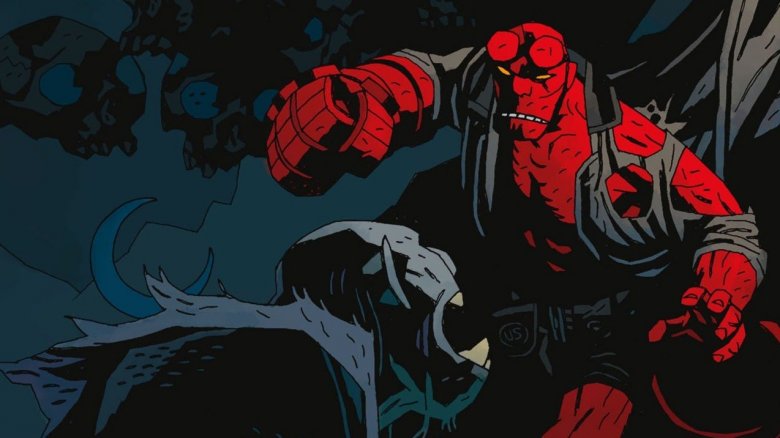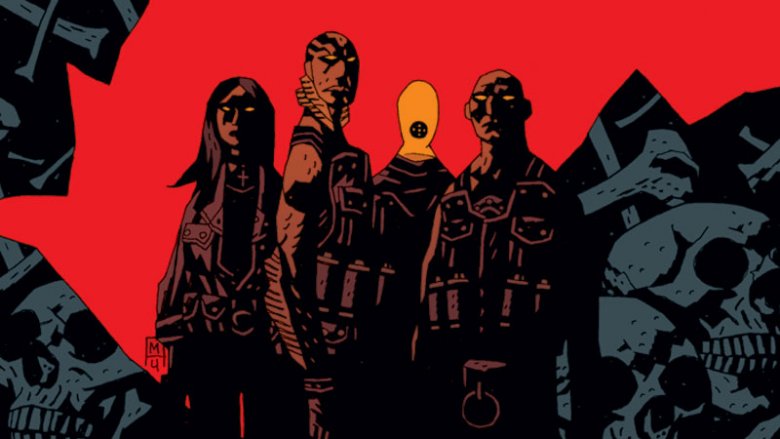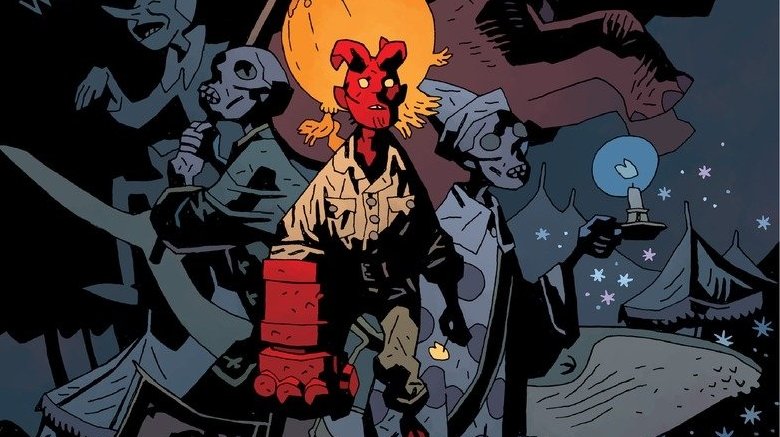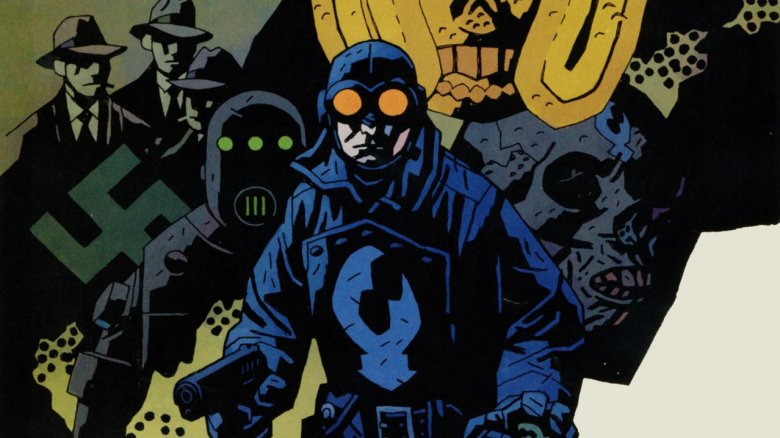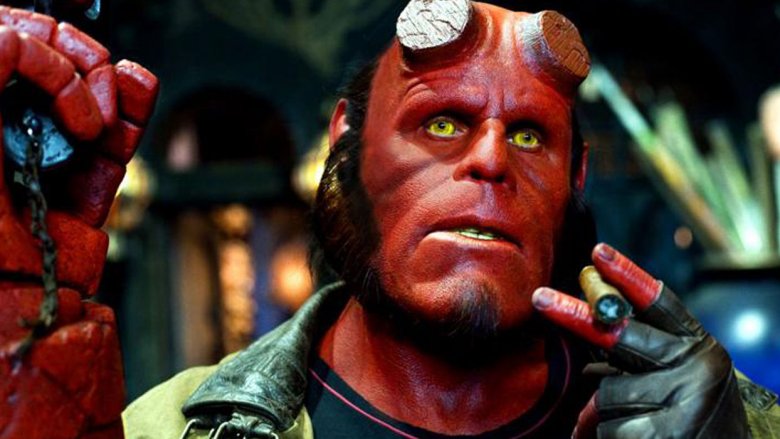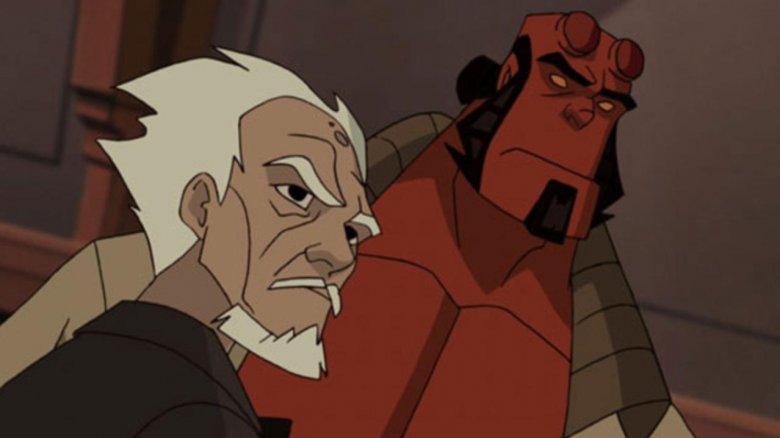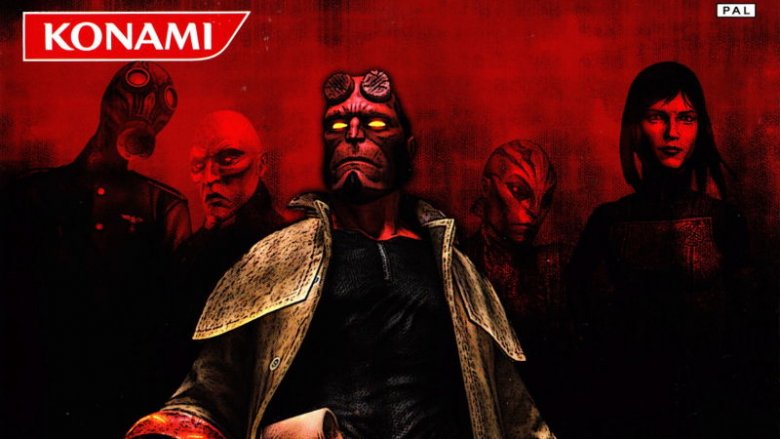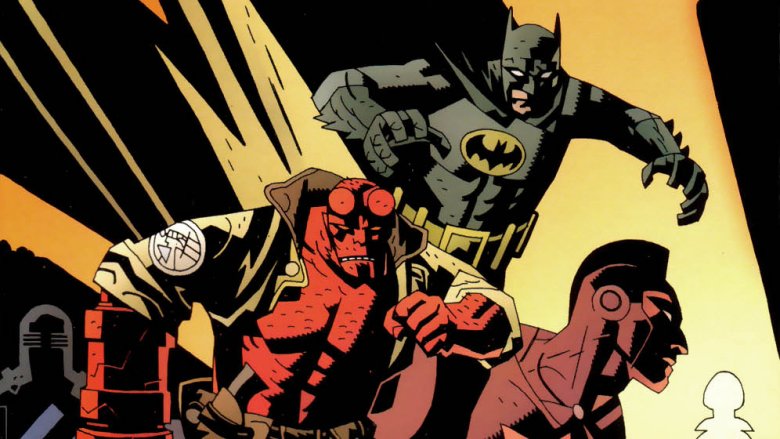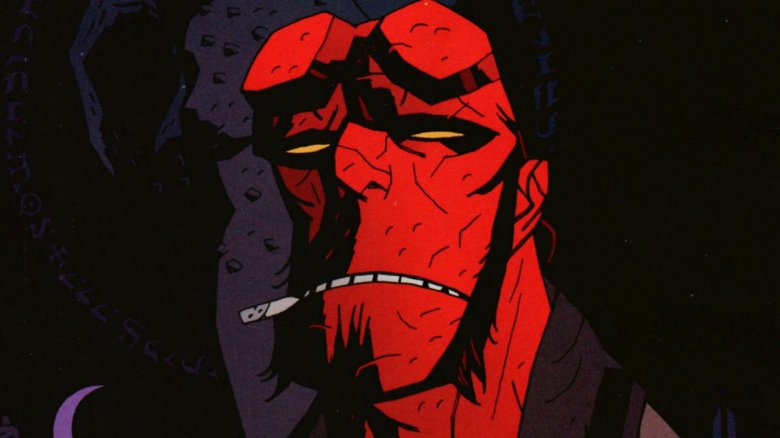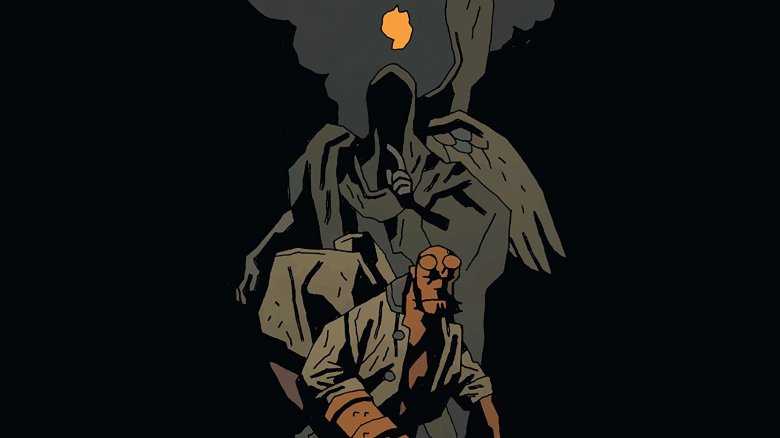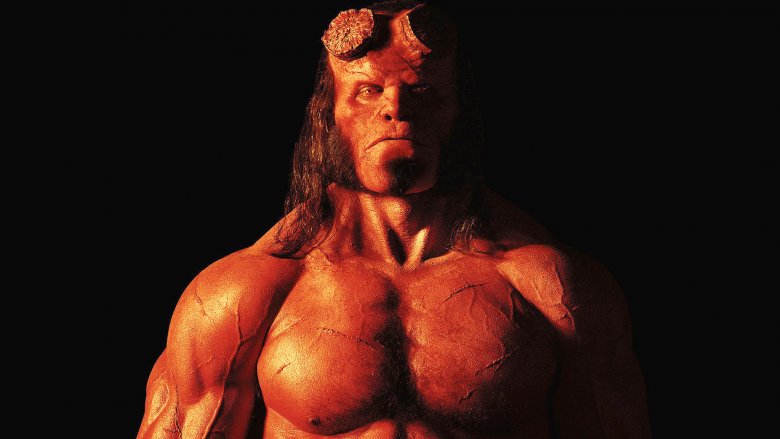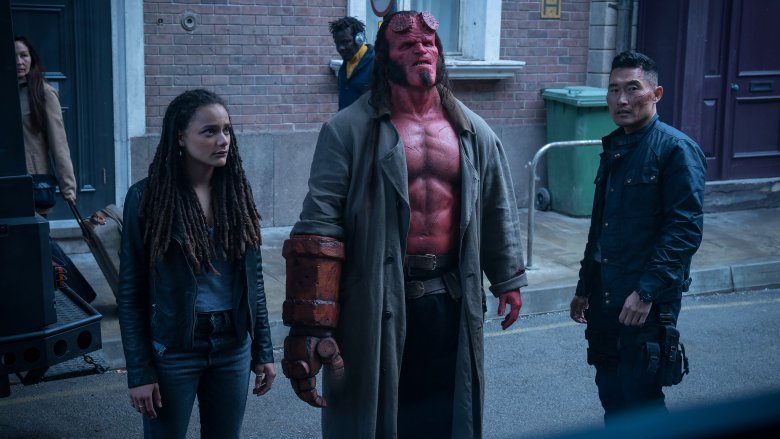The Untold Truth Of Hellboy
There are few characters with more complicated origin stories and paradoxically simple high concepts than Hellboy. The high concept is simple, and best summed up by a line from Hellboy's adopted father in the 2004 live action Hellboy: "There are things that go bump in the night, and we are the ones that bump back." Hellboy is a devil raised as a man; a big, awkward guy who's always ready to fight to save an innocent life. Simple, right? Well, he's also a descendant of King Arthur, a prophesied world destroyer known as Anung Un Rama, and part of a long lineage of pulp heroes.
In short, Hellboy's pretty complicated. With the upcoming live-action reboot poised to tap into some of the weirder corners of the character's long and twisted history, it's the perfect time to unfurl a set of mystical scrolls and look into what makes him tick. From Hellboy's many comic crossover appearances to Ron Perlman's defining screen portrayal to actor David Harbour's casting in the new film, we're diving deep into Hell to discover the untold truth of Hellboy.
Jack Kirby plus H.P. Lovecraft equals Hellboy
Hellboy's conception dates all the way back to 1991, when artist Mike Mignola responded to an open-ended fan request by drawing a massive demon with "Hellboy" printed on the belt buckle. Mignola had been working as an artist for Marvel and DC for years, building up a sizable collection of work and earning himself a loyal contingent of fans, but he wanted to make his own stories — specifically, he wanted to do stories about an occult detective. Remembering his old sketch, he adjusted the design to a more human figure, briefly considered and dismissed the idea of including the character in a team book (supposedly he couldn't think of a good team name), and thus, Hellboy was born in 1993.
The first collection of Hellboy stories, Seed of Destruction, includes an acknowledgement page where Mignola thanks comics legend Jack Kirby and horror novelist H.P. Lovecraft. Those two creators are ingrained in the DNA of Hellboy. Like many of Kirby's most beloved creations (which include Orion, Etrigan, and most of the entire Marvel universe), Hellboy is a bruiser of a character with a tortured and complicated family history. Lovecraft's influence extends to just about everything around the character; the world of Hellboy is filled with horrifying extra-dimensional creatures, grim prophecies, and men brought to madness through cosmic knowledge. The genius of Hellboy is that there are monsters beyond our understanding... but there's also a soft-hearted, brawny brawler who's willing and able to punch it right in its scaly, non-euclidean maw.
Hellboy and the Bureau of Paranormal Research and Defense
Considering that Mignola struggled to think of a team for Hellboy to fit into, it's ironic that Hellboy's eventual team would go on to be so famous in their own right. One of the earliest additions to the Hellboy stories was the idea that Hellboy wasn't just a rogue demon — he worked within a larger framework of equally weird paranormal investigators (and the occasional normal human): the B.P.R.D., which stands for the Bureau of Paranormal Research and Defense. Members included Abe Sapien, an amphibian-human hybrid; Liz Sherman, a pyrokinetic goth with a dark past; Roger the Homunculus, an artificial human activated by Liz; Johann, a German medium reduced to ectoplasmic form; Kate Corrigan, one of the aforementioned regular humans; and Ben Daimio (more on him in a bit). The other members of the B.P.R.D. proved popular enough to anchor their own comic that ran alongside the Hellboy series for years.
Although super-spy organizations focused around paranormal or extraordinary events weren't an unknown element in comic book universes (Marvel's S.H.I.E.L.D. and DC's Checkmate being two notable examples), the B.P.R.D. was remarkably successful in establishing a world beyond Hellboy as a protagonist. The B.P.R.D. comic series even dealt with multiple apocalypses while Hellboy was indisposed (more on that later).
Who is Hellboy's Helldad?
Who is Hellboy, and where does he actually come from? Well, that's a complicated answer that Mignola took his sweet time revealing. To put it simply: Hellboy isn't just a catchy name, it's a surprisingly succinct summary of who he is: he's half Hell, half boy. Half-human and half-demon. His mother was a witch impregnated by one of the Dukes of Hell, Azzael. Although she ultimately renounced her witchiness and tried to seek holy sanctuary in death, Azzael kidnapped her body and forced her to bear Hellboy in Hell. There, Hellboy was given his spooky, apocalyptic name, Anung un Rama (which translates to "and upon his brow is set a crown of flame"). He was also granted his Right Hand of Doom, a relic that connects him to the Ogdru Jahad, a series of Lovecraftian elder gods imprisoned in space.
Simple, right? From tortured circumstances comes a hero — fairly standard stuff. Hold on, though. Hellboy's mother, Sarah, the witch? She was actually the latest in a long lineage of witches that go all the way back to Morgan le Fay. Despite Morgan and King Arthur being half-siblings, the two of them conceived children, one of whom was Sarah's great-great-great-and-so-on grandmother, which makes Hellboy one of the rightful and only descendents of King Arthur. That also means that Hellboy can (and does) wield the holy blade Excalibur as the rightful king of England. Not bad for a red guy with a tail.
Beware my claw, for I've come to inflict justice!
There's more to Hellboy's origin than just his actual family lineage — there's also the heroic lineage that he's been a part of for decades, both in-universe and out. Obviously, Hellboy trades in a lot of pulp tropes and motifs, but Hellboy himself is also the inheritor of a heroic legacy. In the Hellboy universe, there's Lobster Johnson — part the Shadow, part the Spider, with just a smattering of occult spookiness to balance it all out. He's also got one of the all-time best catchphrases to say when killing Nazis: "Beware my claw, for I've come to inflict justice!" Lobster nearly appeared in both Guillermo del Toro Hellboy movies before Mignola vetoed the inclusion on the basis of wanting the character to be as true to the comics as possible.
Interestingly, the first few issues saw Hellboy learning at the feet of a different pulp hero-inspired icon, the Torch of Liberty. This John Byrne creation was loaned out to Mignola for the first few Hellboy stories, when Byrne was assisting on scripting duties. Don't expect to see him again, either in the comics or in any movie adaptations, though; Mignola's said that the character's inclusion in those early stories is a bit awkward since Bryne is the sole owner of the character, making repeat appearances nearly impossible.
Hellboy on the big screen
Noted monster fan and cinephile Guillermo del Toro was no stranger to comics before he signed on to direct Hellboy. In fact, while directing Blade 2 (a movie about a supernaturally powered warrior fighting against his evil lineage with a team of similarly spooky weirdos), del Toro had the opportunity to collaborate with Mignola, who contributed some storyboards for the film. Del Toro spent years pushing for the movie rights to Hellboy and campaigning to direct the film — a quest that ultimately paid off for the auteur. 2004's Hellboy was a modest success, garnering solid reviews and a decent box office (especially considering the difficulty of selling a comic book movie with "Hell" in the title on Easter weekend).
Del Toro made a couple of major departures from the original text, however; one of the most notable was adding a romance between Ron Perlman's Hellboy and Selma Blair's Liz Sherman. Hellboy himself was markedly different as well. Perlman plays Hellboy a bit like an adolescent teenager that's spent too much time locked up in his room. Although he's just as heroic and quick to anger as his comic book counterpart, the movie Hellboy was distinct enough that, supposedly, when Mignola objected to certain elements in the script, del Toro responded: "Your Hellboy wouldn't [do that]. Mine would." The film proved successful enough to greenlight a sequel, Hellboy II: The Golden Army, which would find Mignola's source material largely ignored in favor of an original story by del Toro (although, ironically, parts of the plot would bear a striking similarity to beats from The Wild Hunt, a later story which would source of inspiration for the upcoming movie reboot).
Hellboy on the small screen
Despite receiving solid reviews and another decent chunk of box office profits, Hellboy 2: The Golden Army would spell the end of del Toro and Perlman's conception of the character on the big screen. This was due more to time constraints than the movies being failures — del Toro would spend the next few years of his career trying to get a number of failed projects off of the ground, including At the Mountains of Madness, The Hobbit (which Peter Jackson would soon take over), and others. However, Hellboy 2: The Golden Army wouldn't be the last time that Mignola and del Toro shared shared collaborative history. Guy Davis, one of the few artists who would come to define the look and style of the B.P.R.D. universe, would create character designs for del Toro's giant robot epic, Pacific Rim.
In the meantime, Hellboy stories weren't being shown on the big screen. Instead, a couple of animated adventures, 2006's Hellboy: Sword of Storms and 2007's Hellboy: Blood and Iron were produced. Both films featured the main cast of the live-action films reprising their roles as voice actors in an animated style similar to Mignola's original, shadow-intensive visuals. A third film was greenlit, which would have focused on the pulp hero Lobster Johnson, but it was never produced.
Hellboy on the small screen (again)
While a third live-action del Toro film was never made, fans of the franchise haven't exactly been lacking for the director's touch on the character — in addition to the above animated films, del Toro also produced a video game spinning out of the 2004 movie. Hellboy: The Science of Evil was released in 2008, allowing fans to play as Hellboy, Abe Sapien, and Liz Sherman — all of whom were voiced by their original actors.
The game features a variety of "classic" Hellboy missions, incorporating a number of stories inspired by Mignola's comic work. Big plans were in the works for DLC, which included beloved character actor Bruce Campbell lending his voice to Lobster Johnson, but largely negative reviews squashed that hope. The video game would largely spell the end for del Toro's relationship to the Hellboy character. Although the director would spend much of the next decade banging the drum for a possible third film to complete the trilogy, ultimately the project never came together. Instead, del Toro would win an oscar in for 2017's The Shape of Water, a film that features an amphibian creature with distinct similarities to Abe Sapien, right down to a performance by Doug Jones.
Hellboy and his amazing friends
If all of these multimedia adaptations are making you a little cross-eyed, we don't blame you. For a creator-owned comic about a big red half-demon, Hellboy really gets around, especially in the comics. Besides the many, many spin-offs of the Hellboy series (including B.P.R.D., Lobster Johnson, Abe Sapien, Sir Edward Grey: Witchfinder, and many others), Hellboy's also appeared in other comics by other publishers. He hung out with a group of talking animals that fought the supernatural in Beasts of Burden, messed around in a haunted town with a goon in The Goon, and Mignola even paid Byrne back for his inclusion of the Torch of Liberty in Hellboy by giving Hellboy a cameo in Byrne's series Next Men.
If you're not well-versed in non-superhero comics, the above list might not mean much to you. However, Hellboy did cross over with a character that you'll almost certainly recognize: Batman. In 1999, DC and Dark Horse got together for an intercompany crossover that featured Hellboy meeting up with Batman (along with Starman, a retro-futurist superhero who was popular in the nineties). For fans of Mignola's work on the caped crusader, the crossover was a long time coming. For everyone else, the fact that DC was willing to let Batman cross company lines spoke to Hellboy's growing popularity.
Hellboy and the Wild Hunt
So, that thing about Hellboy being the wielder of Excalibur and also the rightful king of England? Well, with great power there must also come great responsibility, and Hellboy's promotion to non-demonic royalty comes with some heavy burdens in The Wild Hunt. He has to marshal an undead army of England's most noble soldiers in battle against Nimue, the Queen of Blood.
As is surprisingly common in Hellboy stories, he flips off fate and makes his own way. In this case, leaving Excalibur for someone else to wield as he pushes his way through and around an army to face off against Nimue, now transformed into a part of the Ogdru Jahad. Hellboy's able to kill her with a sword forged from a small portion of her own humanity, reborn as one-third of a raven crown (Hellboy comics get weird), but he does so at the cost of his own life. Nimue rips Hellboy's heart out, finally killing the half-demon hero, and sending him down into Hell.
Hellboy in Hell
Still, like many superheroes, just because Hellboy died doesn't mean that his story is over. He's half-demon, after all, so the afterlife is a bit more flexible for him than it would be for most. In Hellboy in Hell, Hellboy wandered through Hell, deposing various kings and demonic deities, and ultimately coming to terms with his own demonic legacy. That series seemed to end with Hellboy finally getting the rest he's spent most of his life looking for, retiring in a small, pleasant corner of Hell.
As you might expect, that retirement wasn't exactly permanent. Hellboy was recently resurrected for the final arc of B.P.R.D.: The Devil You Know, and Mignola's hinted that the character is going to go through another bout of pain and suffering. Over the decades of publication, Hellboy has transformed from an experienced paranormal investigator into a world-weary demonic savior exhausted by the constant apocalypses. As David Harbour takes over for Ron Perlman, we'll have to see if that modern-day characterization is reflected in Neil Marshall's upcoming Hellboy movie.
Hellboy on the big screen once again
It's been a long time coming, but in 2019, Hellboy will once again appear on the big screen. By all accounts, the new movie will be largely inspired by The Wild Hunt, along with a sampling of other Hellboy and B.P.R.D. storylines (eagle-eyed comic readers might have spotted one of the massive monsters that emerged during the apocalyptically-titled B.P.R.D.: Hell on Earth storyline in the trailer). What's most interesting is the way that David Harbour's portrayal of Hellboy will differ from Ron Perlman's. Perlman's natural gruff world-weariness was lessened somewhat by del Toro's interest in portraying Hellboy as an adolescent — there's a reason that one of the most honest conversations to happen in the 2004 movie is between Hellboy and an actual child talking about their frustrations.
Harbour, as is fitting considering his role as Jim Hopper in Stranger Things, seems to be tapping into Hellboy as Mignola would later write him. As Mignola has said, he based the character somewhat on his father, "a guy who's been in the Korean War and he's traveled and he's done a lot of stuff, and he's kind of got a 'been there, done that' attitude." The upcoming film is also going to be rated R, which should be an interesting change from both the previous films and the comics, which have rarely ventured into "F-bomb" territory.
Ben Daimio and Alice
Speaking of that upcoming movie, there are a couple of major players featured in the trailer that haven't gotten their due in the past live-action films. First off, there's Major Ben Daimio, a Japanese-American (likely changed to Korean-American, considering Daniel Dae Kim's casting) soldier who's involvement in the B.P.R.D. comes after he's killed by a Jaguar-worshipping cult. He's resurrected (naturally), but he's also cursed to become a were-jaguar at night, an ability that's much less useful than it sounds. In the movie, it seems like he'll have his curse more under control, participating with Hellboy in a fight against what looks to be the fairy creature Gruagach.
Alice, meanwhile, is deeply connected to The Wild Hunt, and likely the movie as well. In the comics, she was briefly kidnapped by fairies before getting rescued by Hellboy. However, her time in the faerie realm gave her extra-sensory perception and a reduced aging rate. In the film, she'll be portrayed by Sasha Lane, and seems to be much more of a bruiser than her comics counterpart, using what look to be magically powered brass knuckles to punch monsters.

